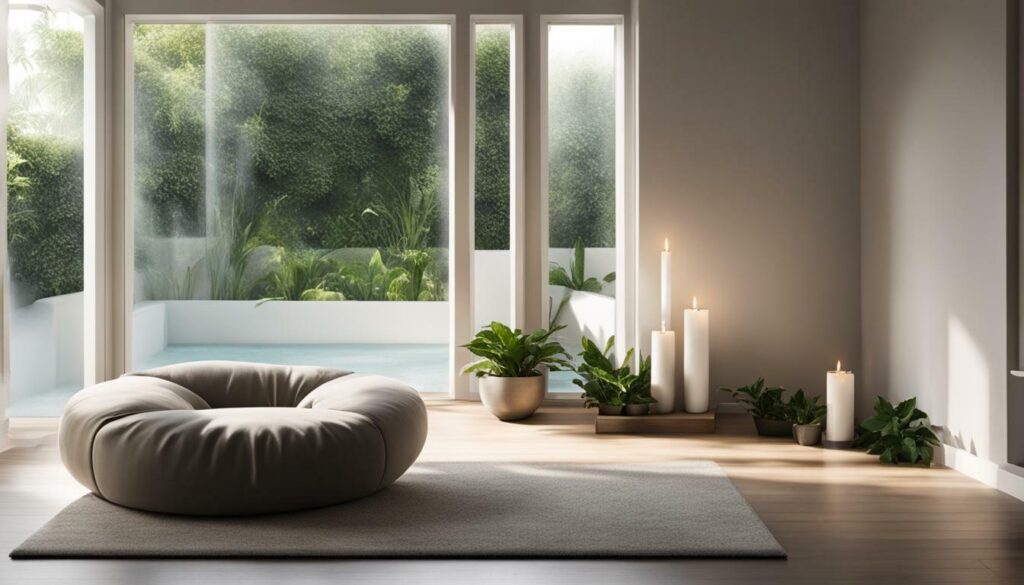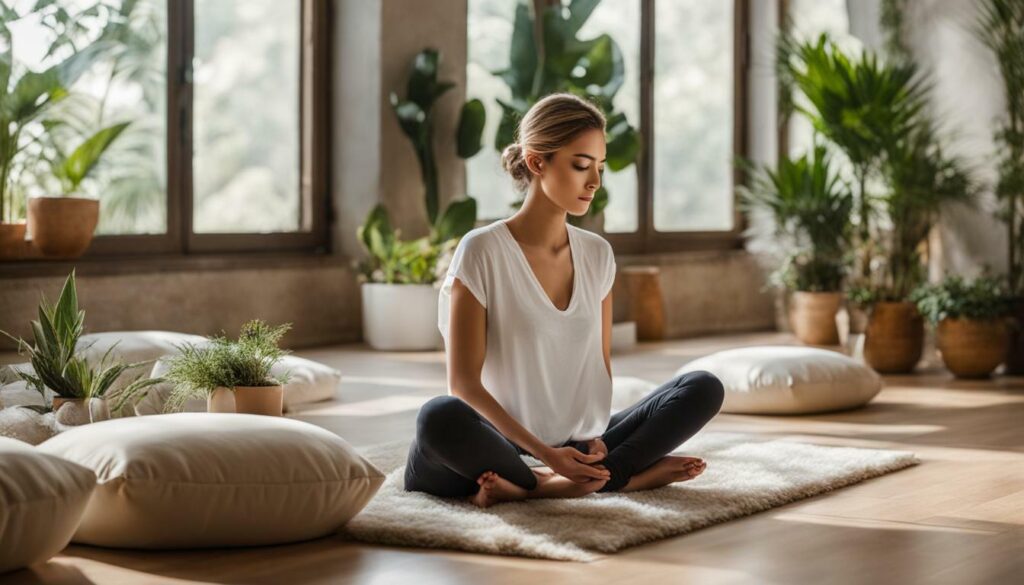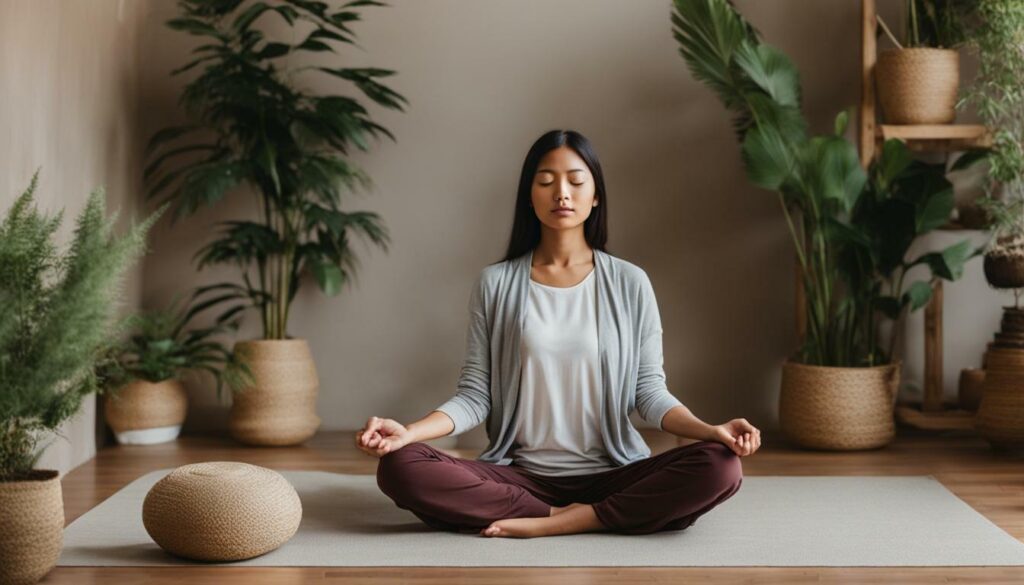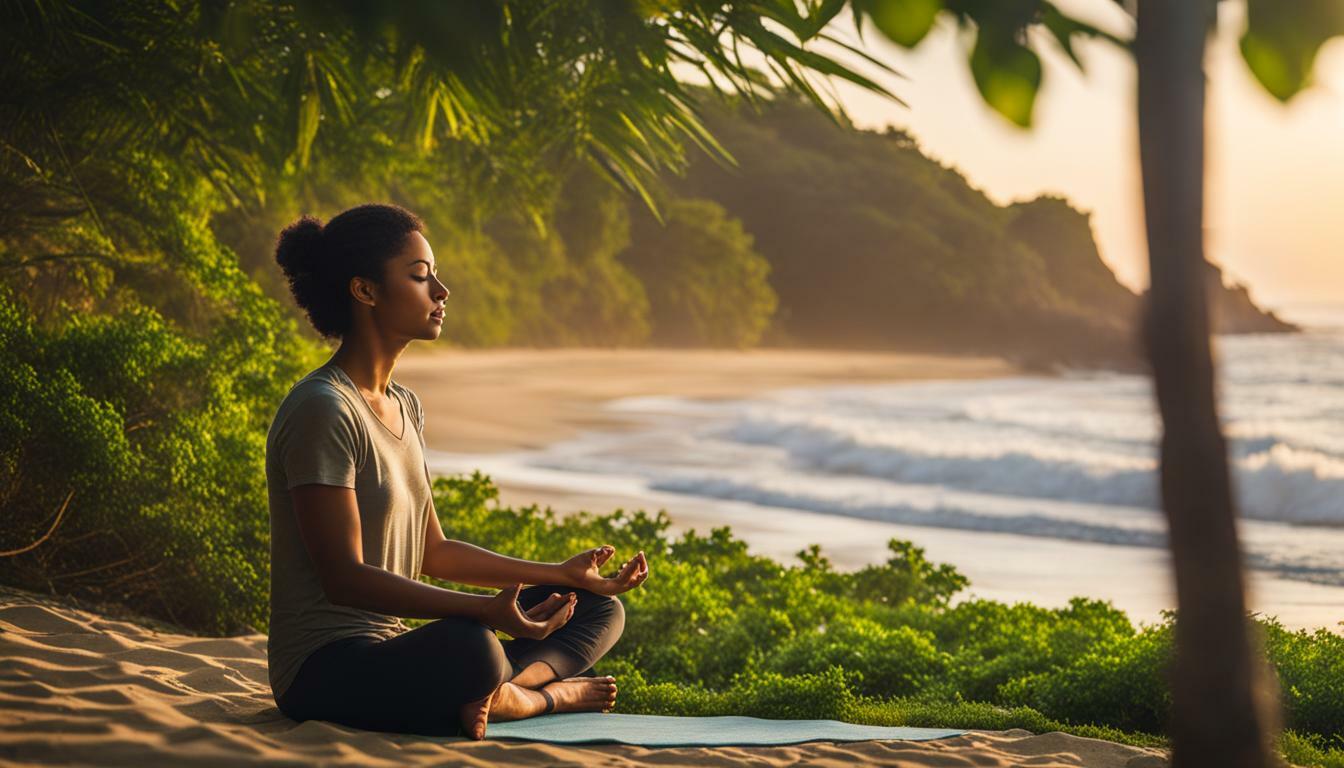Guided meditation practices offer a pathway to peaceful living, nurturing the tranquility of the mind and fostering a sense of inner calm. When we engage in guided meditation, we allow ourselves to be guided by a trained practitioner or audio recording, incorporating mindfulness and relaxation techniques into our practice. The benefits are profound and impact our mental health positively, improving our focus, reducing symptoms of depression and anxiety, and increasing feelings of relaxation and well-being.
- Guided meditation practices can promote peaceful living and improve mental health.
- Benefits include improved focus, reduced symptoms of depression and anxiety, and increased feelings of relaxation and well-being.
- To start a guided meditation practice, create a peaceful meditation space and find a comfortable posture.
- Focus on the breath as an anchor to the present moment, embracing thoughts without judgment.
- Consider using guided meditations or mantras to deepen the experience.
Understanding Guided Meditation Techniques
Guided meditation techniques encompass a range of practices that cultivate mindfulness, relaxation, and self-awareness, leading to enhanced mental clarity and emotional well-being. These techniques provide a structured approach to meditation, making it accessible and beneficial for individuals at all levels of experience.
One common technique is mindfulness meditation, which involves focusing one’s attention on the present moment without judgment. By observing thoughts, sensations, and emotions with curiosity and acceptance, practitioners develop a heightened sense of self-awareness and gain insight into their inner workings.
Another technique frequently used in guided meditation is relaxation. This involves consciously releasing tension from the body and quieting the mind. Through deep breathing exercises, progressive muscle relaxation, and visualization, individuals can induce a state of deep relaxation and tranquility.
Guided Meditation Techniques
| Technique | Description |
|---|---|
| Mindfulness Meditation | Focusing on the present moment without judgment. |
| Relaxation | Releasing tension and inducing a state of relaxation. |
| Visualization | Using mental imagery to create a calming environment. |
| Loving-Kindness Meditation | Cultivating feelings of love, compassion, and kindness towards oneself and others. |
By incorporating these techniques in guided meditation sessions, individuals can experience a myriad of benefits, including reduced stress, improved focus and memory, enhanced emotional well-being, and increased overall life satisfaction. Guided meditation allows individuals to tap into their inner resources and find peace and calm amidst the chaos of daily life.
Quote: “Meditation is not a way of making your mind quiet. It’s a way of entering into the quiet that’s already there – buried under the 50,000 thoughts the average person thinks every day.” – Deepak Chopra
Guided meditation techniques offer a pathway to achieving a state of deep relaxation and self-discovery. Whether you are a beginner or an experienced practitioner, these techniques provide a framework to cultivate mindfulness, release stress, and nurture personal growth. By exploring the diverse range of guided meditation practices available, you can unlock the profound benefits that this ancient practice holds.

Engaging in guided meditation practices yields a plethora of benefits, including profound stress relief, heightened mental clarity, and a strengthened sense of emotional well-being. By embarking on this transformative journey, individuals can cultivate inner peace and experience a greater sense of overall wellbeing.
Guided meditation offers a valuable tool for managing stress and promoting relaxation. It allows individuals to disconnect from the pressures of daily life and enter a state of deep relaxation, helping to alleviate physical tension and mental strain. Through guided meditation, practitioners can unwind, release negative energy, and achieve a profound sense of tranquility.
Mental clarity is another significant benefit of guided meditation. By focusing the mind and directing attention to the present moment, guided meditation enhances cognitive function and improves concentration. Regular practice can lead to increased mental clarity, sharper focus, and enhanced problem-solving skills.
In addition to stress relief and mental clarity, guided meditation fosters emotional well-being. This practice encourages individuals to embrace their thoughts and emotions without judgment, promoting self-acceptance and emotional balance. Through guided meditation, practitioners develop greater self-awareness, emotional resilience, and a deeper connection with their inner selves.
By incorporating guided meditation into their daily routines, individuals can experience the transformative benefits of improved stress management, heightened mental clarity, and enhanced emotional well-being. The simple act of setting aside time for guided meditation allows for self-reflection, self-discovery, and personal growth. Unlock the potential within yourself and embark on a journey towards a more peaceful and fulfilled life.
Benefits of Guided Meditation
| Benefit | Description |
|---|---|
| Stress Relief | Guided meditation promotes deep relaxation and helps alleviate physical and mental stress. |
| Mental Clarity | By focusing the mind and practicing mindfulness, guided meditation enhances cognitive function and improves concentration. |
| Emotional Well-being | The practice of embracing thoughts and emotions without judgment fosters self-acceptance and emotional balance. |
| Self-Discovery and Growth | Regular guided meditation sessions offer opportunities for self-reflection, self-discovery, and personal growth. |

Establishing a dedicated space for guided meditation is essential to set the stage for tranquility and deep introspection. By creating a peaceful sanctuary within your home, you can cultivate an environment that promotes relaxation and mindfulness during your meditation practice. Here are some tips to help you create your own meditation space:
- Choose a quiet location: Find a corner or a room in your home where you can have some privacy and minimize distractions. This could be a spare room, a quiet corner of your bedroom, or even a peaceful spot outdoors.
- Create a comfortable seat: Invest in a meditation cushion or a comfortable chair that supports good posture. Make sure the seat allows your hips to be slightly higher than your knees, promoting relaxation and ease while meditating.
- Add calming elements: Decorate your space with items that evoke a sense of peace and serenity. Consider incorporating soft lighting, natural elements like plants, and soothing colors such as blues or earth tones.
- Minimize clutter: Keep your meditation space clean and clutter-free to create a sense of calm and order. Remove any unnecessary items that may distract you during your practice.
- Personalize your space: Make your meditation space feel like your own by adding personal touches. This could be a meaningful photograph, a favorite quote, or objects that hold special significance to you.

By dedicating a space solely for meditation, you are sending a signal to your mind and body that it is time for introspection and self-care. It provides a physical and mental boundary that helps you transition into a state of relaxation and presence.
Essential Elements for a Peaceful Meditation Space
| Element | Description |
|---|---|
| Quiet Location | Choose a place in your home that is free from distractions and noise. |
| Comfortable Seat | Invest in a meditation cushion or chair that supports good posture. |
| Calming Elements | Add items such as soft lighting, plants, and soothing colors to create a serene atmosphere. |
| Minimal Clutter | Keep your space clean and organized to promote a sense of calm and focus. |
| Personal Touches | Add objects that hold personal significance to make the space feel uniquely yours. |
Creating a peaceful meditation space is an invitation to prioritize self-care and introspection in your life. It serves as a gentle reminder to carve out time for yourself and cultivate inner peace amidst the busyness of daily life. With a dedicated space that reflects your personal taste and preferences, you can immerse yourself fully in the practice of guided meditation and experience its transformative benefits.
Finding Your Comfortable Posture
Discovering a comfortable posture during guided meditation is crucial for deepening the experience and fostering a greater connection with oneself. The right posture allows the body to relax, promoting a sense of ease and focus. Here are some tips to help you find your ideal position:
- Choose a quiet and peaceful space: Find a location where you can sit undisturbed for the duration of your meditation. This could be a corner of your home or a designated meditation area. Ensure the space is free from distractions and creates a calm ambiance.
- Find a comfortable seat: Whether you prefer sitting on a cushion, a chair, or the floor, choose a seat that supports your body and allows you to maintain a relaxed yet alert posture. You may experiment with different options to find what works best for you.
- Align your body: Sit with a straight spine, aligning your head, neck, and back. Imagine a string pulling your head upwards, elongating your spine. This alignment promotes good posture and facilitates deep breathing.
- Relax your muscles: Release any tension in your body by consciously relaxing your muscles. Start from the top of your head and progressively work your way down, relaxing your forehead, jaw, shoulders, and limbs. Let go of any tightness or stiffness, allowing your body to feel at ease.
Remember, the goal is to find a posture that is comfortable and supportive for your body. Trust your instincts and make any necessary adjustments to ensure your meditation posture feels natural and relaxed. With time and practice, you will discover the position that allows you to fully immerse yourself in the guided meditation experience.

The Importance of Posture
“The posture you choose for meditation can profoundly affect your state of mind and the quality of your practice.”
The way we hold our body while meditating can significantly impact our ability to cultivate a calm and focused state of mind. A relaxed and aligned posture enables the breath to flow freely, supporting deep relaxation and mental clarity.
| Benefits of a Comfortable Posture | Benefits of an Aligned Posture |
|---|---|
|
|
By finding a comfortable and aligned posture, you create the optimal conditions for a deep and transformative meditation practice. So, take a moment to explore different positions, listen to your body, and trust the wisdom within. Embrace the power of a comfortable posture and embark on a journey of self-discovery, peace, and well-being.
Focusing on the Breath as an Anchor
The breath serves as a steadfast anchor during guided meditation, grounding the mind and facilitating a profound sense of presence. As you settle into your meditation practice, bring your attention to the natural rhythm of your breath. Observe the inhalations and exhalations, noticing the sensation of the breath entering and leaving your body. Allow each breath to guide you deeper into a state of relaxation and inner calm.
By focusing on the breath, you can cultivate mindfulness and redirect your attention away from distractions. As thoughts arise, gently acknowledge them without judgment, and then gently bring your focus back to your breath. This process of coming back to the breath helps train the mind to remain present, enhancing your ability to stay centered and engaged in the practice.
To deepen your experience, you can experiment with different techniques that involve breath awareness. One common technique is counting the breaths, where you count from one to ten with each inhalation and exhalation. This practice can help anchor your attention and provide a focal point for your mind throughout the meditation session. Alternatively, you can engage in deep, slow breathing to promote relaxation and release tension.
Remember, the breath is always there, offering you a continuous point of focus. As you become more skilled in using the breath as an anchor, you may find that you can carry the sense of presence and calm into your everyday life. Take a moment now to close your eyes, take a deep breath, and simply be present with the breath, allowing it to guide you into a state of peace and tranquility.

| Benefits of Focusing on the Breath as an Anchor |
|---|
| Enhances mindfulness and present-moment awareness |
| Reduces stress and promotes relaxation |
| Improves mental clarity and focus |
| Calms the mind and reduces racing thoughts |
“Inhale, and God approaches you. Hold the inhalation, and God remains with you. Exhale, and you approach God.” – Krishnamacharya
Related Techniques
- Mindful Breathing Meditation
- Alternate Nostril Breathing
- Box Breathing
Embracing Thoughts Without Judgment
Guided meditation invites the practice of observing thoughts and emotions without judgment, nurturing self-compassion and cultivating a greater understanding of the mind. This practice encourages individuals to create a safe space within themselves, where they can explore their thoughts, emotions, and experiences with curiosity and acceptance.
When engaging in guided meditation, it is common for thoughts to arise. Instead of trying to suppress or control these thoughts, the practice encourages individuals to embrace them without judgment. This means acknowledging the thoughts as they come and allowing them to pass through the mind without attaching any labels or value judgments to them.
By embracing thoughts without judgment, individuals can develop a deeper sense of self-awareness and self-compassion. They can observe their thoughts and emotions with kindness and understanding, recognizing that these are natural and transient experiences. This practice helps to cultivate a greater sense of inner peace and well-being, as individuals learn to let go of self-criticism and develop a more gentle and compassionate relationship with themselves.
| Benefits of Embracing Thoughts Without Judgment: |
|---|
| 1. Increased self-compassion and self-acceptance |
| 2. Reduced stress and anxiety |
| 3. Improved emotional well-being |
| 4. Enhanced self-awareness and mindfulness |
“When we embrace our thoughts without judgment, we create space for growth and transformation.”
Embracing thoughts without judgment is a fundamental aspect of guided meditation practices. It allows individuals to develop a more harmonious relationship with their thoughts, emotions, and experiences, fostering personal growth and transformation on their journey towards a more peaceful and fulfilling life.

Guided meditations and mantras serve as valuable aids in guided meditation, guiding the mind and inviting a sense of serenity. They provide a framework for focusing the attention and cultivating a state of calm and relaxation. Guided meditations often involve verbal cues and visualizations, helping to create a deep sense of presence and awareness.
When practicing guided meditation, following along with a guided meditation recording can be beneficial. These recordings typically provide step-by-step instructions, guiding you through the meditation process. They may include soothing background music and calming nature sounds to enhance the meditative experience.
Mantras, on the other hand, are repetitive phrases or sounds that can help quiet the mind and induce a meditative state. Chanting a mantra can be particularly effective in focusing the attention and quieting the mental chatter. Common mantras include “Om” and “Om Namah Shivaya,” but you can also create your own mantra that resonates with you personally.
| Guided Meditations | Mantras |
|---|---|
| Provide step-by-step instructions | Repetitive phrases or sounds |
| Guided by a trained practitioner or recording | Can quiet the mind and induce meditation |
| Enhanced with soothing music and nature sounds | Focuses the attention and reduces mental chatter |
Incorporating guided meditations or mantras into your guided meditation practice can deepen your experience and help you achieve a greater sense of tranquility and clarity. Experiment with different guided meditations and mantras to find what resonates with you personally. Remember, the goal is not to achieve a specific outcome or reach a particular state of mind, but rather to be present and cultivate a sense of inner peace and well-being.

For beginners, embarking on a guided meditation journey begins with the commitment to start small and maintain consistency, gradually integrating meditation into daily life. It can be overwhelming to jump into longer meditation sessions right away, so it’s important to set realistic expectations. Starting with just a few minutes of guided meditation each day can make it more manageable and sustainable in the long run. As you become more comfortable, you can gradually increase the duration of your meditation sessions.
Consistency is key when it comes to reaping the benefits of guided meditation. It’s better to meditate for a few minutes every day rather than attempting longer sessions sporadically. Creating a daily meditation routine helps to establish a habit and make meditation a natural part of your daily life. Set aside a specific time and place for your practice, making it a priority in your schedule. Whether it’s early morning, during a lunch break, or before bed, find a time that works best for you and stick to it.
To stay consistent, it can be helpful to use reminders or meditation apps that offer guided sessions. These resources provide structure and accountability, making it easier to stay on track with your meditation practice. Surround yourself with supportive and like-minded individuals who can encourage and motivate you on your journey. Joining meditation groups or attending online classes can also provide valuable guidance and support.
Remember, meditation is a personal experience, and it’s normal to have both good and challenging sessions. Be kind to yourself and embrace the process with patience and compassion. Each meditation session is an opportunity for self-discovery and growth, allowing you to cultivate a sense of peace and well-being in your life.

| Benefits of Starting Small and Staying Consistent |
|---|
| 1. Establishing a habit: By starting small and maintaining consistency, you can develop a regular meditation practice that becomes a natural part of your routine. |
| 2. Building focus: Consistent meditation helps to improve focus and concentration, allowing you to better navigate daily challenges and tasks. |
| 3. Managing stress and anxiety: Regular meditation can reduce stress levels and promote a sense of calm, helping you manage anxiety and find inner peace. |
| 4. Enhancing self-awareness: By committing to regular meditation, you can deepen your understanding of yourself and your emotions, fostering personal growth. |
The Path of Self-Discovery and Growth
Guided meditation opens the door to a transformative path of self-discovery and growth, nurturing self-awareness and amplifying personal development. Through the practice of guided meditation, individuals can embark on a journey of exploration, gaining valuable insights about themselves and the world around them.
By cultivating self-awareness, guided meditation allows individuals to develop a deeper understanding of their thoughts, emotions, and behaviors. It provides a space for reflection and self-exploration, helping uncover hidden patterns, beliefs, and desires. This heightened self-awareness can lead to personal growth as individuals become more attuned to their needs, values, and aspirations.
Moreover, guided meditation fosters a sense of presence and mindfulness, enabling individuals to fully experience each moment without judgment or attachment. This practice enhances the ability to stay present and attentive in daily life, reducing stress and enhancing overall well-being. It allows individuals to develop a greater capacity for compassion and acceptance, both towards themselves and others.
Benefits of Guided Meditation for Self-Discovery and Growth:
- Increased self-awareness
- Enhanced mindfulness
- Improved clarity and focus
- Deeper connection to inner self
- Heightened emotional intelligence
Combining self-awareness with mindfulness, guided meditation creates a fertile ground for personal development and transformation. Each meditation session becomes an opportunity for self-reflection, growth, and the nurturing of a deeper connection to oneself.
As individuals embark on their guided meditation practice, they are encouraged to approach it with an open mind and curiosity. By embracing this transformative path, individuals can unlock their true potential, discover hidden strengths, and cultivate a life rooted in mindfulness, self-awareness, and personal growth.

Building a Daily Meditation Routine
Cultivating a daily guided meditation routine is key to unlocking the full potential of the practice, fostering a consistent state of peace and well-being. By dedicating time each day to immerse yourself in the practice, you can experience the transformative benefits that meditation has to offer. Whether you are a beginner or have some experience with meditation, establishing a daily routine can help you deepen your practice and maintain a sense of balance in your life.
One of the first steps in building a daily meditation routine is to create a peaceful meditation space. Find a quiet corner or room in your home where you can retreat to without any distractions. You may want to decorate this space with calming elements such as plants, candles, or soft lighting to create a serene environment. Having a designated space will signal to your mind and body that it’s time to focus inward and cultivate inner peace.
Once you have your meditation space set up, finding a comfortable posture is essential. Whether you choose to sit on a cushion, a chair, or even lie down, it’s important to find a position that allows your body to relax and remain still. Maintaining good posture will help you stay alert and attentive during your meditation practice.
During your guided meditation sessions, focus on your breath as an anchor to the present moment. Notice the sensation of each inhale and exhale, allowing your breath to guide your attention away from thoughts and into the present experience. Embrace thoughts that arise without judgment, acknowledging them and letting them pass by gently. To enhance your practice, you may also consider using guided meditations or mantras, which can provide additional guidance and support in deepening your focus and relaxation.

| Benefits of a Daily Meditation Routine |
|---|
| Improved focus and concentration |
| Reduced stress and anxiety |
| Enhanced emotional well-being |
| Increased self-awareness and mindfulness |
| Improved overall mental and physical health |
Starting small and staying consistent is key to establishing a daily meditation routine. Begin with just a few minutes each day and gradually increase the duration over time. Set a specific time for your practice, whether it’s first thing in the morning, during a lunch break, or in the evening before bed. By incorporating meditation into your daily routine, you’ll not only reap the benefits of a peaceful mind but also build resilience and inner strength to navigate life’s challenges with grace and ease.
Conclusion
Guided meditation practices offer a profound pathway to peaceful living, providing beginners with the tools to embark on a transformative journey of self-discovery, emotional well-being, and inner growth. By incorporating mindfulness and relaxation techniques, guided meditation can have a positive impact on mental health, improving focus, reducing symptoms of depression and anxiety, and increasing feelings of relaxation and well-being.
To start a guided meditation practice, it is essential to create a peaceful meditation space, finding a quiet and comfortable environment that promotes relaxation and focus. Exploring different postures and finding a comfortable position can support deep relaxation during the practice. Focusing on the breath as an anchor to the present moment can help calm the mind and bring attention to the present moment.
Embracing thoughts without judgment is an important aspect of guided meditation, where mindfulness is cultivated by accepting thoughts and emotions that arise during the practice. Guided meditations or mantras can deepen the meditation experience, providing guidance and support for a focused and tranquil state of mind.
For beginners, starting small and staying consistent is key to building a sustainable guided meditation habit. By integrating meditation into a daily routine, individuals can fully experience the transformative benefits of this practice. Each meditation session becomes an opportunity for self-discovery and personal growth, cultivating self-awareness and fostering inner peace.
FAQ
What is guided meditation?
Guided meditation is a practice that involves following the instructions of a trained practitioner or audio recording. It incorporates mindfulness and relaxation techniques to promote peaceful living and improve mental health.
What are the benefits of guided meditation?
Guided meditation has numerous benefits, including improved focus, reduced symptoms of depression and anxiety, and increased feelings of relaxation and well-being.
How do I start a guided meditation practice?
To start a guided meditation practice, create a peaceful meditation space, find a comfortable posture, focus on the breath as an anchor to the present moment, embrace thoughts without judgment, and consider using guided meditations or mantras. It is important to start small and stay consistent, integrating meditation into a daily routine.
How can guided meditation help with stress relief?
Guided meditation can help with stress relief by promoting relaxation, reducing anxiety, and improving overall mental well-being. It allows you to cultivate a sense of calm and mindfulness, helping to alleviate the effects of stress on the body and mind.
Is guided meditation suitable for beginners?
Yes, guided meditation is suitable for beginners. It provides a structured approach to meditation, offering guidance and support throughout the practice. Starting small and staying consistent is key for beginners to build a sustainable meditation routine.
How long should a guided meditation session be?
The length of a guided meditation session can vary depending on personal preference and availability. It is recommended to start with shorter sessions, such as 5-10 minutes, and gradually increase the duration as you become more comfortable with the practice.









